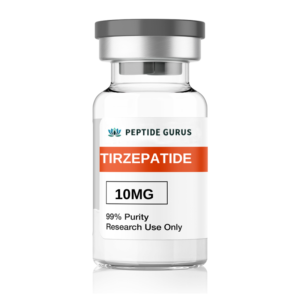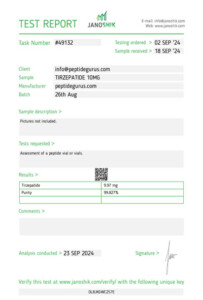In the realm of medical research and treatment, tirzepatide peptide has emerged as a significant player, especially in addressing type 2 diabetes and obesity. This article delves into the intricate mechanism of action of
tirzepatide peptide, while also taking into account the product details from
our website and the latest FDA guidelines.
What is Tirzepatide?
Tirzepatide is a synthetic peptide that functions as a dual agonist, targeting both the glucose – dependent insulinotropic polypeptide (GIP) receptor and the glucagon – like peptide – 1 (GLP – 1) receptor. It consists of 39 amino acids and is an analog of the gastric inhibitory polypeptide. In 2022, the FDA gave its approval for tirzepatide’s use in the treatment of type 2 diabetes mellitus. Its unique dual – receptor – agonism sets it apart from many other medications in the field.
The Mechanism of Action
Dual Receptor Activation
- GLP – 1 Receptor Agonism: When tirzepatide binds to the GLP – 1 receptor, it initiates a cascade of beneficial effects. One of the primary actions is enhancing glucose – stimulated insulin secretion from the pancreas. This means that when blood sugar levels rise, tirzepatide helps the pancreas release more insulin, which in turn helps cells take up glucose from the bloodstream, thus reducing hyperglycemia. Additionally, it delays gastric emptying. This slowdown in the emptying of the stomach contents into the small intestine leads to a more gradual absorption of nutrients, preventing rapid spikes in blood sugar levels. It also reduces glucagon secretion. Glucagon is a hormone that raises blood sugar levels by promoting the breakdown of glycogen in the liver. By reducing glucagon secretion, tirzepatide further contributes to better glycemic control. These actions also play a role in appetite suppression, which can lead to a reduction in body mass.
- GIP Receptor Agonism: The GIP receptor agonist component of tirzepatide has several important functions. It is believed to enhance the insulinotropic effects of the peptide. In simpler terms, it boosts the ability of tirzepatide to stimulate insulin release. It also contributes to improvements in insulin sensitivity, which is crucial for cells to respond more effectively to insulin. Moreover, it plays a part in both first – and second – phase insulin secretion. The first – phase insulin secretion is the initial burst of insulin release in response to rising blood sugar, while the second – phase is a more sustained release. GIP receptor agonism by tirzepatide helps optimize these insulin – releasing processes.
Overall Impact on Metabolism
Tirzepatide’s combined actions on GIP and GLP – 1 receptors lead to a more significant reduction in hyperglycemia compared to GLP – 1 agonist agents alone. By improving glycemic control and reducing appetite, it can also lead to substantial weight loss. In fact, clinical trials have demonstrated dose – dependent weight reduction with tirzepatide. For example, in some studies, a 5 mg dose of tirzepatide led to a weight reduction of 5.4 kg, and at a 15 mg dose, the weight reduction was 10.5 kg over a certain period.
FDA’s Role and Guidance
The FDA’s approval of tirzepatide for type 2 diabetes in 2022 came after rigorous evaluation. The agency’s guidelines cover various aspects of the drug’s use.
Indications
The FDA has clearly defined that tirzepatide is approved for treating type 2 diabetes mellitus. It is important to note that it is not approved for type 1 diabetes mellitus, and its safety and efficacy in patients with pancreatitis have not been established, so it should not be used in such cases.
Administration and Monitoring
Tirzepatide is administered subcutaneously via injection, and it comes in different dosages such as 2.5 mg/0.5 ml, 5 mg/0.5 ml, 7.5 mg/0.5 ml, 10 mg/0.5 ml, 12.5 mg/0.5 ml, and 15 mg/0.5 ml. The standard dosing is once – weekly, with the usual starting dose being 5 mg/0.5 ml. Healthcare providers are required to adjust the dose based on the patient’s hemoglobin A1c levels, body weight, and tolerance to adverse effects. The FDA emphasizes the need to monitor patients for potential side effects, especially gastrointestinal issues which are common with tirzepatide use.
Safety and Side Effects
The FDA has also taken into account the potential adverse effects of tirzepatide. The most commonly reported side effects are gastrointestinal, including nausea, diarrhea, and abdominal discomfort. There have also been reports of injection – site reactions, such as redness, swelling, and itching. Although rare, serious side effects like acute pancreatitis and acute kidney injury have been observed, and these require immediate medical attention. The agency requires healthcare providers to be vigilant in monitoring patients for these side effects and to educate patients about what to look out for.
Our Tirzepatide Product
Our tirzepatide product, available in a 10 mg formulation, is designed to meet the needs of researchers and medical professionals in further exploring the potential of this peptide. It is crucial to handle and use the product in accordance with strict guidelines. The product should be stored as per the recommended conditions to maintain its stability and effectiveness. When using it for research purposes, it is essential to follow ethical and scientific protocols.
FAQs
- Q: Can I use tirzepatide to treat my type 1 diabetes?
A: No, tirzepatide is only FDA – approved for the treatment of type 2 diabetes mellitus. It has not been studied or approved for type 1 diabetes, and its use in this context is not recommended as it may not be effective and could potentially have unknown risks.
- Q: How long does it take for tirzepatide to start showing effects on blood sugar and weight?
A: The time it takes for tirzepatide to show effects can vary from person to person. Generally, improvements in blood sugar control, as measured by hemoglobin A1c levels, may start to be noticeable within a few weeks of consistent use. Weight loss may also start to occur gradually over the first few weeks, but significant changes are often seen over a period of months, typically around 3 – 6 months of continuous treatment. However, individual factors such as diet, exercise, and overall health can influence these timings.
- Q: What should I do if I experience severe side effects while using tirzepatide?
A: If you experience severe side effects such as severe abdominal pain (which could be a sign of acute pancreatitis), sudden changes in urine output or swelling in the legs (potential signs of acute kidney injury), or any other concerning symptoms, stop using
tirzepatide immediately and seek medical attention right away. Your healthcare provider can evaluate your condition and provide appropriate guidance and treatment.

